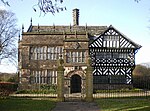Sharples School
1974 establishments in EnglandAcademies in the Metropolitan Borough of BoltonEducational institutions established in 1974Greater Manchester school stubsSecondary schools in the Metropolitan Borough of Bolton ... and 1 more
Use British English from February 2023
Sharples School is a co-educational secondary school located in the Sharples area of Bolton in the English county of Greater Manchester.Established in 1974, the School celebrated its 40th anniversary in 2014.Previously a community school administered by Bolton Metropolitan Borough Council, in June 2016 Sharples School converted to academy status. The school continues to coordinate with Bolton Metropolitan Borough Council for admissions. Sharples School offers GCSEs, BTECs and the CiDA as programmes of study for pupils. The school also has a specialism in STEM (Science, Engineering, Technology and Maths).
Excerpt from the Wikipedia article Sharples School (License: CC BY-SA 3.0, Authors).Sharples School
Hill Cot Road,
Geographical coordinates (GPS) Address Website External links Nearby Places Show on map
Geographical coordinates (GPS)
| Latitude | Longitude |
|---|---|
| N 53.60733 ° | E -2.42456 ° |
Address
Sharples School (Sharples High School)
Hill Cot Road
BL1 8SN , Bank Top
England, United Kingdom
Open on Google Maps





